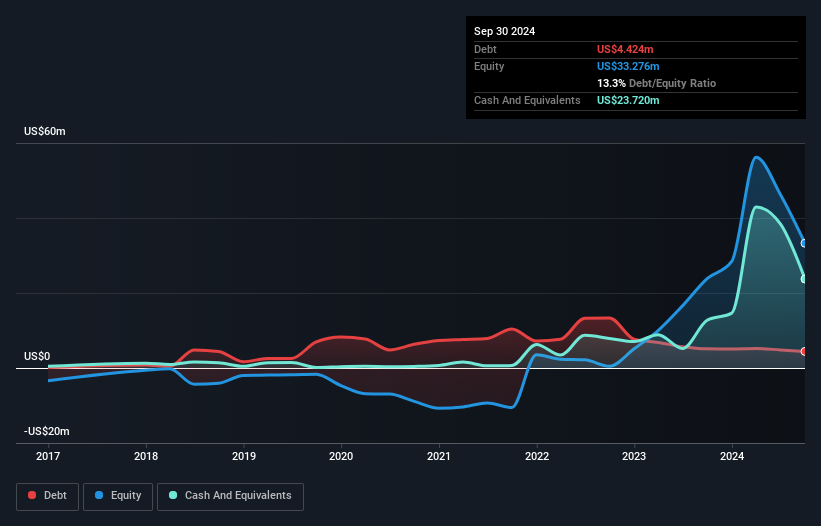
Warren Buffett famously said, 'Volatility is far from synonymous with risk.' So it might be obvious that you need to consider debt, when you think about how risky any given stock is, because too much debt can sink a company. We can see that SurgePays, Inc. (NASDAQ:SURG) does use debt in its business. But the real question is whether this debt is making the company risky.
What Risk Does Debt Bring?
Generally speaking, debt only becomes a real problem when a company can't easily pay it off, either by raising capital or with its own cash flow. In the worst case scenario, a company can go bankrupt if it cannot pay its creditors. However, a more frequent (but still costly) occurrence is where a company must issue shares at bargain-basement prices, permanently diluting shareholders, just to shore up its balance sheet. Of course, debt can be an important tool in businesses, particularly capital heavy businesses. When we think about a company's use of debt, we first look at cash and debt together.
Check out our latest analysis for SurgePays
What Is SurgePays's Debt?
The image below, which you can click on for greater detail, shows that SurgePays had debt of US$4.42m at the end of September 2024, a reduction from US$5.11m over a year. But on the other hand it also has US$23.7m in cash, leading to a US$19.3m net cash position.

A Look At SurgePays' Liabilities
We can see from the most recent balance sheet that SurgePays had liabilities of US$5.43m falling due within a year, and liabilities of US$2.79m due beyond that. On the other hand, it had cash of US$23.7m and US$1.51m worth of receivables due within a year. So it actually has US$17.0m more liquid assets than total liabilities.
This surplus liquidity suggests that SurgePays' balance sheet could take a hit just as well as Homer Simpson's head can take a punch. Having regard to this fact, we think its balance sheet is as strong as an ox. Simply put, the fact that SurgePays has more cash than debt is arguably a good indication that it can manage its debt safely. The balance sheet is clearly the area to focus on when you are analysing debt. But it is future earnings, more than anything, that will determine SurgePays's ability to maintain a healthy balance sheet going forward. So if you're focused on the future you can check out this free report showing analyst profit forecasts.
In the last year SurgePays had a loss before interest and tax, and actually shrunk its revenue by 41%, to US$84m. That makes us nervous, to say the least.
So How Risky Is SurgePays?
By their very nature companies that are losing money are more risky than those with a long history of profitability. And the fact is that over the last twelve months SurgePays lost money at the earnings before interest and tax (EBIT) line. Indeed, in that time it burnt through US$12m of cash and made a loss of US$23m. With only US$19.3m on the balance sheet, it would appear that its going to need to raise capital again soon. Overall, its balance sheet doesn't seem overly risky, at the moment, but we're always cautious until we see the positive free cash flow. There's no doubt that we learn most about debt from the balance sheet. But ultimately, every company can contain risks that exist outside of the balance sheet. Be aware that SurgePays is showing 4 warning signs in our investment analysis , you should know about...
When all is said and done, sometimes its easier to focus on companies that don't even need debt. Readers can access a list of growth stocks with zero net debt 100% free, right now.
New: Manage All Your Stock Portfolios in One Place
We've created the ultimate portfolio companion for stock investors, and it's free.
• Connect an unlimited number of Portfolios and see your total in one currency
• Be alerted to new Warning Signs or Risks via email or mobile
• Track the Fair Value of your stocks
Have feedback on this article? Concerned about the content? Get in touch with us directly. Alternatively, email editorial-team (at) simplywallst.com.
This article by Simply Wall St is general in nature. We provide commentary based on historical data and analyst forecasts only using an unbiased methodology and our articles are not intended to be financial advice. It does not constitute a recommendation to buy or sell any stock, and does not take account of your objectives, or your financial situation. We aim to bring you long-term focused analysis driven by fundamental data. Note that our analysis may not factor in the latest price-sensitive company announcements or qualitative material. Simply Wall St has no position in any stocks mentioned.
About NasdaqCM:SURG
SurgePays
Operates as a financial technology and telecom company in the United States.
Undervalued with high growth potential.
Market Insights
Community Narratives




